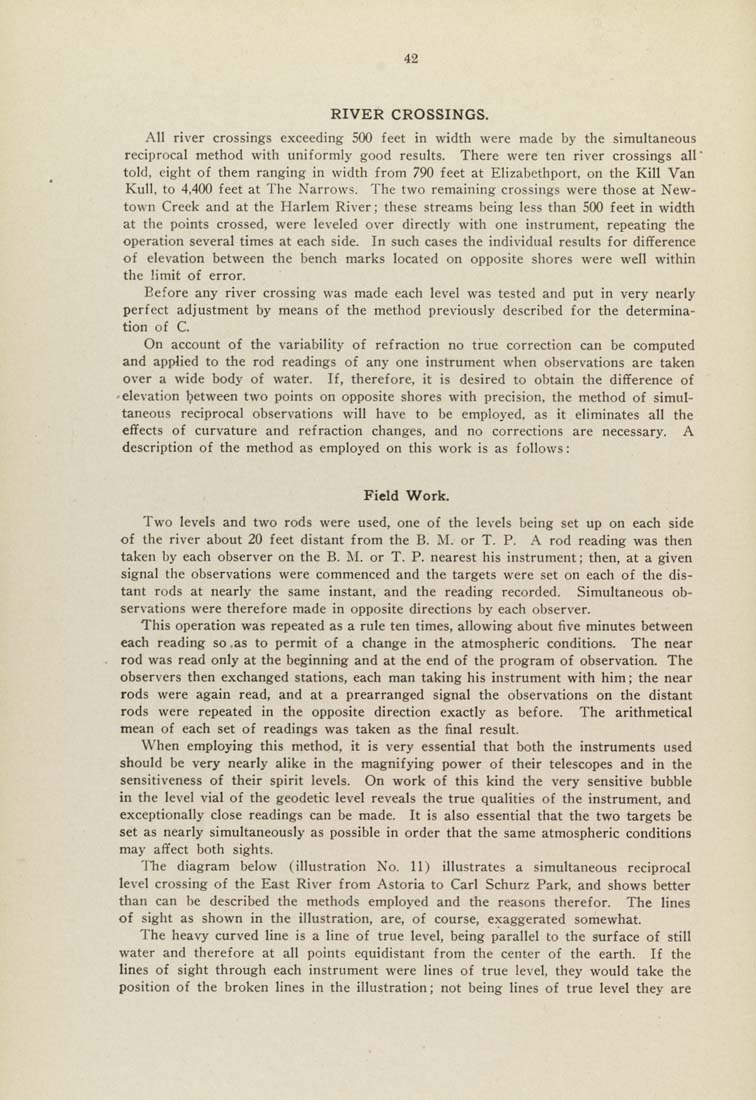RIVER CROSSINGS.
All river crossings exceeding 500 feet in width were made by the simultaneous
reciprocal method with uniformly good results. There were ten river crossings all"
told, eight of them ranging in width from 790 feet at Elizabethport, on the Kill Van
Kull, to 4,400 feet at The Narrows. The two remaining crossings were those at New¬
town Creek and at the Harlem River; these streams being less than 500 feet in width
at the points crossed, were leveled over directly with one instrument, repeating the
operation several times at each side. In such cases the individual results for difference
of elevation between the bench marks located on opposite shores were well within
the limit of error.
Before any river crossing was made each level was tested and put in very nearly
perfect adjustment by means of the method previously described for the determina¬
tion of C,
On account of the variability of refraction no true correction can be computed
and applied to the rod readings of any one instrument when observations are taken
over a wide body of water. If, therefore, it is desired to obtain the difference of
■elevation ^)etween two points on opposite shores with precision, the method of simul¬
taneous reciprocal observations will have to be employed, as it eliminates all the
effects of curvature and refraction changes, and no corrections are necessary. A
description of the method as employed on this work is as follows:
Field Work.
Two levels and two rods were used, one of the levels being set up on each side
of the river about 20 feet distant from the B. M. or T. P, .\ rod reading was then
taken by each observer on the B. M. or T. P. nearest his instrument; then, at a given
signal the observations were commenced and the targets were set on each of the dis¬
tant rods at nearly the same instant, and the reading recorded. Simultaneous ob¬
servations were therefore made in opposite directions by each observer.
This operation was repeated as a rule ten times, allowing about five minutes between
each reading so .as to permit of a change in the atmospheric conditions. The near
rod was read only at the beginning and at the end of the program of observation. The
observers then exchanged stations, each man taking his instrument with him; the near
rods were again read, and at a prearranged signal the observations on the distant
rods were repeated in the opposite direction exactly as before. The arithmetical
mean of each set of readings was taken as the final result.
When employing this method, it is very essential that both the instruments used
should be very nearly alike in the magnifying power of their telescopes and in the
sensitiveness of their spirit levels. On work of this kind the very sensitive bubble
in the level vial of the geodetic level reveals the true qualities of the instrument, and
exceptionally close readings can be made. It is also essential that the two targets be
set as nearly simultaneously as possible in order that the same atmospheric conditions
may affect both sights,
'ITie diagram below (illustration No. 11) illustrates a simultaneous reciprocal
level crossing of the East River from Astoria to Carl Schurz Park, and shows better
than can be described the methods employed and the reasons therefor. The lines
of sight as shown in the illustration, are, of course, exaggerated somewhat.
The heavy curved line is a line of true level, being parallel to the surface of still
water and therefore at all points equidistant from the center of the earth. If the
lines of sight through each instrument were lines of true level, they would take the
position of the broken lines in the illustration; not being lines of true level they are
|








